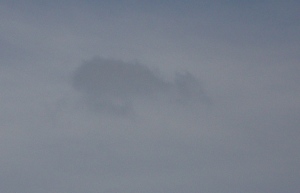Admiral Francis Beaufort spent enough time with both his own diary and his ships logs to recognize the importance of making naval reports more uniform and useful. Everyone really has a different idea of what sort of breeze is “gentle” or “strong”, so he thought it would be useful to choose terms that would be more universal by their relationship with specific observations — and after about 32 years, the Royal Navy agreed. This is the origin of the Beaufort Wind Scale, which has been adapted for land use by adding observations that apply to trees and houses — not just waves!
Of course modern weathermen — on land or at sea — use wind speeds in knots, miles, or kilometers per hour, but it sometimes happens that these more objective and specific measures — so important in official reports — have the effect of making us less observant. Somebody asks for the wind speed, and we run for the newspaper or the phone instead of looking out the window. In this way, we detach ourselves from experience. Notice the weather!
In your weather observations, use drawings as well as words, and describe the evidence of the wind, not just the numeric speed. You will see more that way. Here’s a very simple chart to use.
30 chart alone
Meantime, unable to resist the opportunity to make something more accessible through verse, I have put Beaufort’s work to rhyme.
Beaufort Wind Scale
Beaufort naught leaves ponds like glass
Reflected swans for real may pass.
Zero wind leaves water like a mirror; and smoke rises straight up.
Drifting smoke is Beaufort 1
Water scales; but waves are none.
A slight wind causes water to have the appearance of fish scales; smoke drifts a little.
I turn my face to Beaufort 2
While glassy waves touch my canoe.
A little more wind actually makes waves and can be felt on the face.
A gentle breeze is Beaufort 3
Rustling leaves and just-breaking sea.
As wind speed approaches 10 mph, the waves become strong enough to break, and on land, the leaves rustle without ceasing.
Branchlets move for Beaufort 4
And milk-white horses trot ashore.
The next sign of strengthening wind is a little white on the cresting waves; still not threatening, but getting brisk. Small branches move in this wind.
Beaufort 5, a fresh’ning breeze,
Lengthens waves and bends young trees.
Somewhere near 20 mph, the wind begins to bend young trees. Waves become longer, and the “white horses” become numerous and insistent.
Whistling wires are Beaufort 6
Men with umbrellas are in a fix!
If you use an umbrella, you know that sometimes the wind is just too strong. At sea, this is when the spray begins to come up.
With heaping seas and blowing foam
‘Gainst Beaufort 7, ’tis hard to roam.
Eventually, even the human body is so buffeted as to make it hard to walk in the wind. This is about 30 mph.
Snapping twigs — spindrift at sea
Beaufort 8 is the gale for me!
We really have a storm now — a gale. Small parts of trees and plants begin to break in the wind, and the foam is blown above the water. This gets us up to 40 mph. “Gale” has a specific meaning for Beaufort; not just big storm, but these specific observations.
Beaufort 9 is a howling gale
Testing the ship and the roofing nail.
Nobody likes to lose shingles, but it happens; and you better have a solid ship if you are at sea.
Trees by the root and ships in a wave
Beaufort 10 is a terrible knave.
Basically, this is just below hurricane force.
If you’re on board for B-11
Best prepare to knock at heaven.
Hurricane. Anyone can be hurt; any building is up for grabs.
Read Full Post »



